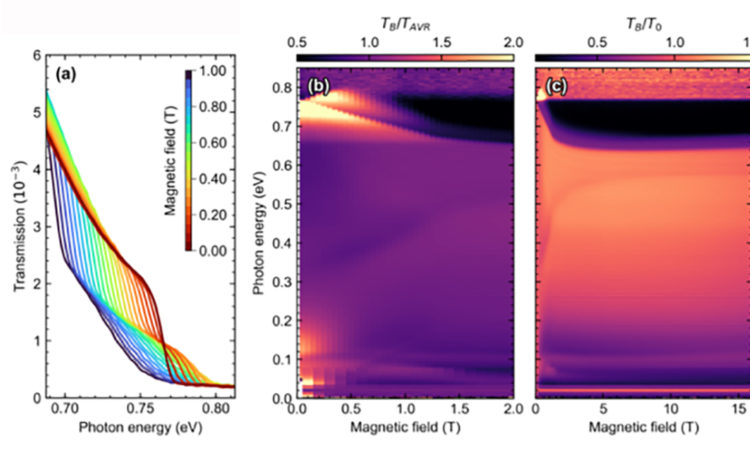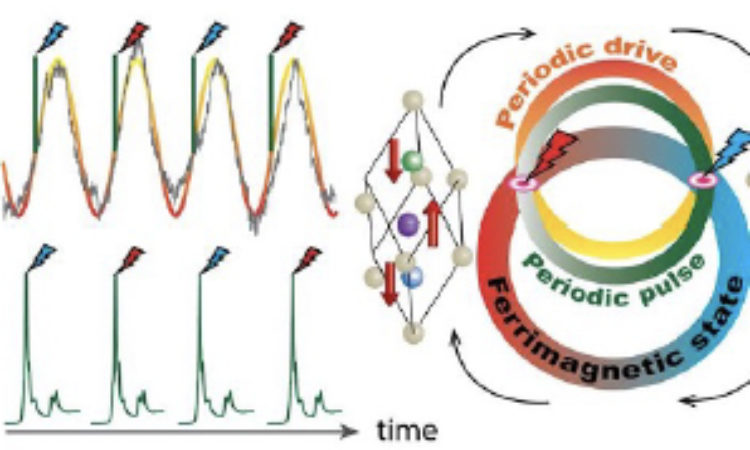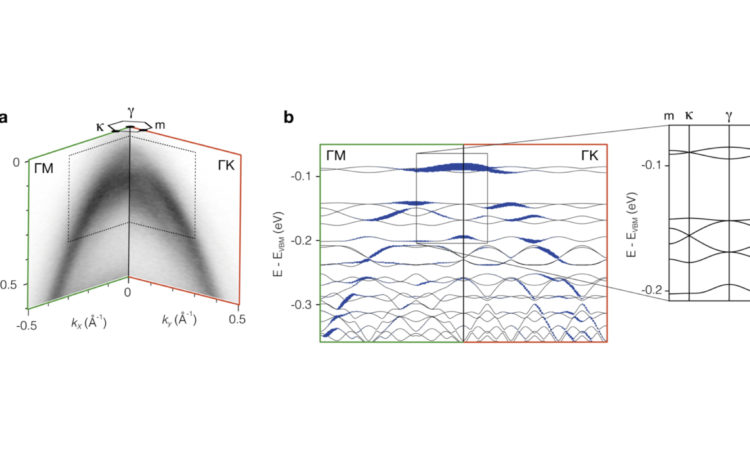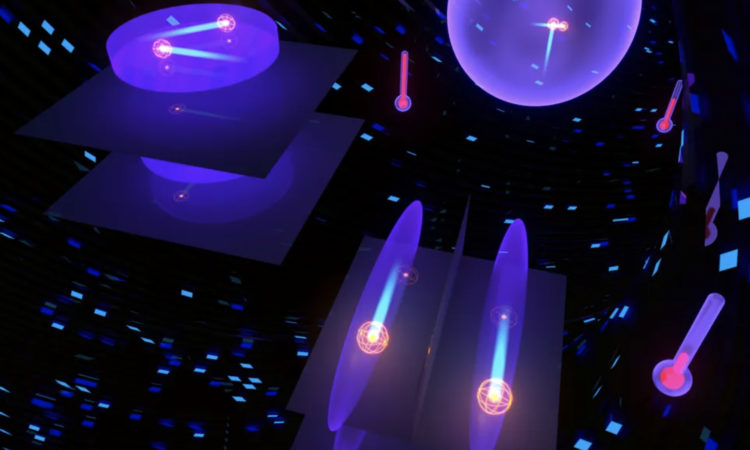Not so superficial: intriguing physics atop strontium titanate
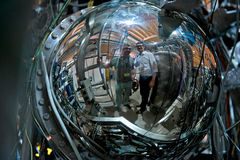
Over the past decade, interfaces between oxide materials have been intensely studied, due to the powerful and often unexpected properties they can exhibit. New research using angle-resolved photoemission is revealing that another kind of “interface” – an oxide material’s surface – can be just as fascinating. Investigating a recently discovered surface state on SrTiO3, a collaboration of scientists from the Swiss Light Source, EPFL, and Université Paris-Sud has found strong evidence of giant so-called Rashba spin splitting, as well as magnetism.
Read the PSI and EPFL press release
Photo: Milan Radović and Nicholas Plumb at the X09LA beamline at the SLS
Credit: Markus Fischer – Paul Scherrer Institut

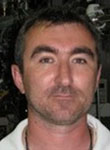
By Nicholas C. Plumb and Milan Radović, Swiss Light Source, Paul Scherrer Institut
Based on article published in Nature Materials
In its bulk, the transition metal oxide SrTiO3 (STO) is a nonmagnetic insulator. However, at its interface, e.g., with LaAlO3 (LAO), STO can come to life with conductivity [1]. In order to better engineer powerful oxide-based multifunctional devices, much research is focused on better understanding the surprising physics that can emerge whenever oxides form interfaces. Historically, “interface” has meant the junction between two materials, but recently oxide surfaces – interfaces with vacuum – are attracting attention as well.
In 2011, researchers using angle-resolved photoemission spectroscopy (ARPES) discovered that a metallic state could be formed on STO’s surface [2, 3]. ARPES measures the energy and momentum of photo-emitted electrons, thereby directly probing electronic band structure. With further experiments, a fairly complete picture of the STO surface state has emerged. It is composed of energetically split sets of subbands with Ti 3dxy and 3dxz/3dyz characters. The 3dxy electrons are quasi-2D, with their Fermi surfaces forming a set of concentric cylinders. By contrast, the 3dxz/3dyz bands are 3D, in the sense that their Fermi surfaces are closed in momentum space [4]. Crucially, however, the 3dxz/3dyz electrons effective masses are enhanced in the out-of-plane direction. The interpretation is that the 3dxy electrons must be highly confined to the surface, whereas the 3dxz/3dyz bands permeate into the subsurface region – albeit a bit “sluggishly”.
The recent progress in understanding the surface of STO has been capped by yet another surprising observation. Spin-resolved ARPES measurements indicate that the electrons’ spins in each 3dxy subband are locked tangential to their Fermi surface sheets, and the spin textures of the inner and outer sheets have opposite winding [5]. The spin splitting is consistent with the so-called Rashba effect, which by itself would not be so surprising: Rashba splitting is observed at many surfaces and interfaces, due to the combined effects of spin-orbit coupling and the electric field from the broken translational symmetry. In the case of STO, though, the size of the spin-splitting (~100 meV) is almost an order of magnitude larger than naively expected, and also larger than the Rashba splitting observed in LAO/STO [6] In addition, a Rashba state by itself would have a time-reversal symmetry-protected degeneracy point where the two oppositely spin-polarized bands intersect. On STO’s surface, however, this degeneracy appears to be broken. Hence the measurements imply the additional presence of magnetism, which, notably, has also been observed in LAO/STO [7]. ARPES, however, cannot say which kind of magnetic order exists (ferromagnetic, spin spiral, etc.), nor can it reveal whether the magnetism is local or itinerant. These are important questions for future experiments to answer. Despite the relatively direct nature of the spin-resolved ARPES measurements, the surprising conclusions about the existence of giant Rashba splitting and magnetism on STO are likely to generate controversy.
Other experimental techniques, such as transport, should attempt to test the findings. This will not be an easy task, however, since exactly how the surface state arises is not well understood. The lab conditions necessary to form and preserve the conductivity seem to be precisely those used by ARPES: ultrahigh vacuum, relatively low temperatures, and a healthy dose of photons. In fact, STO that starts out as totally insulating becomes conducting on its surface as it is irradiated in the ARPES experiments. On this basis, it would seem that photo-induced defects account for the carriers – and they very well might. However, a number of facts show that the surface doping does not go straightforwardly. For instance, the measured Fermi surfaces of variously etched, fractured, annealed, or doped samples are all virtually identical, meaning that their carrier densities are the same. Moreover, spectral changes seen during irradiation imply that the oxygen valence electrons undergo strong changes in orbital character as the metal is being formed [4]. Taking into account surface structural distortions and their influence on the electric field that confines the carriers, for example, might help to better understand these behaviors, as well as play a role in the large Rashba splitting.
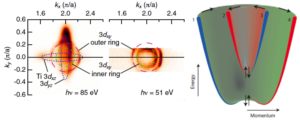
[1] A. Ohtomo, A. and H. Y. Hwang, A high-mobility electron gas at the LaAlO3/SrTiO3 heterointerface, Nature, 427, 423-426 (2004).
[2] W. Meevasana, et al., Creation and control of a two-dimensional electron liquid at the bare SrTiO3 surface, Nature Materials 10, 114-118 (2011).
[3] A. F. Santander-Syro, et al., Two-dimensional electron gas with universal subbands at the surface of SrTiO3, Nature 469, 189-193 (2011).
[4] N. C. Plumb et al., Mixed Dimensionality of Confined Conducting Electrons in the Surface Region of SrTiO3, Physical Review Letters 113, 086801 (2014).
[5] A. F. Santander-Syro et al., Giant spin splitting of the two-dimensional electron gas at the surface of SrTiO3, Nature Materials 13, 1085-1090 (2014).
[6] A. Fête, et al., Large modulation of the Shubnikov-de Haas oscillations by the Rashba interaction at the LaAlO3/SrTiO3 interface, New Journal of Physics 16, 112002 (2014).
[7] Brinkman et al., Magnetic effects at the interface between non-magnetic oxides, Nature Materials 6, 493-496 (2007).
